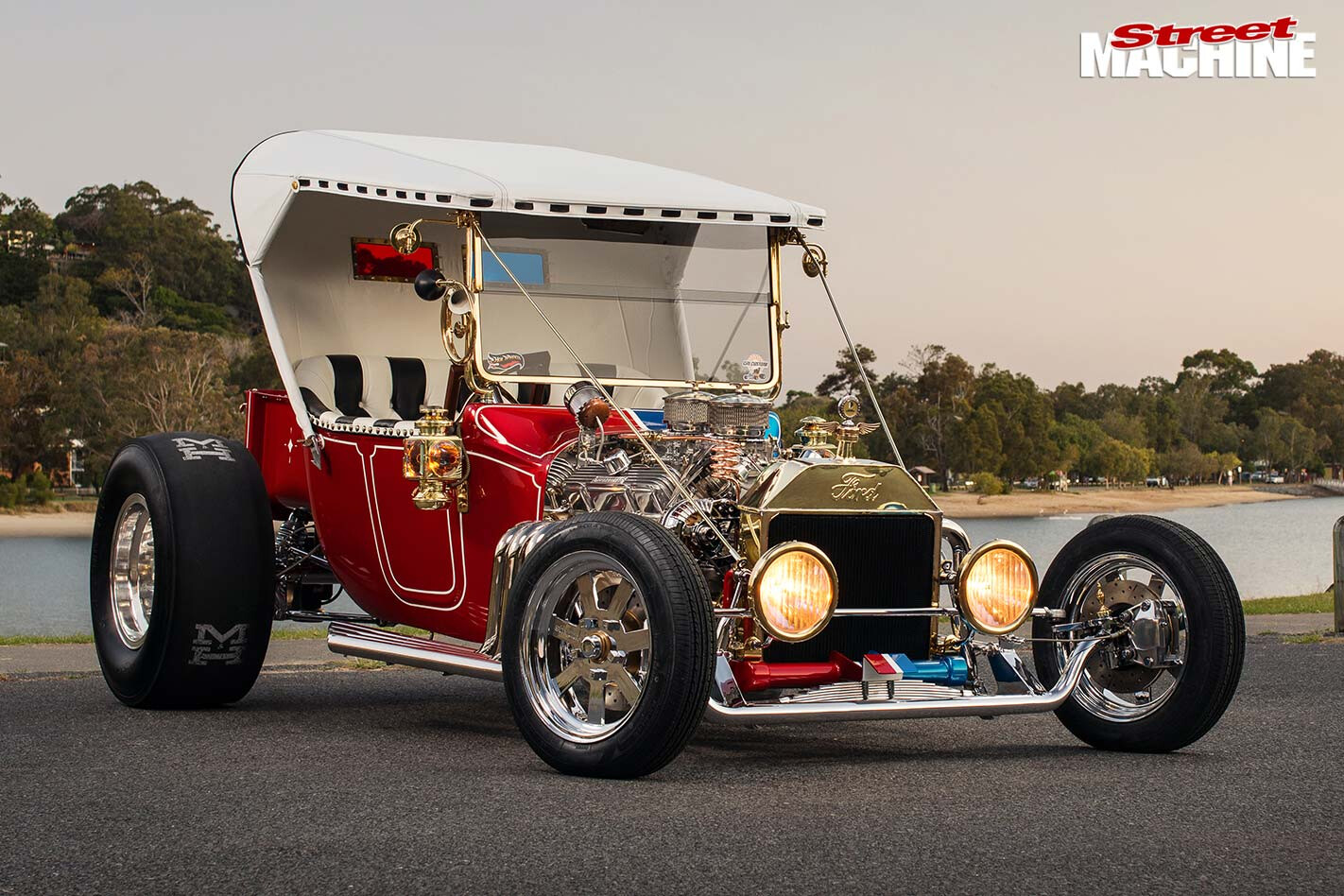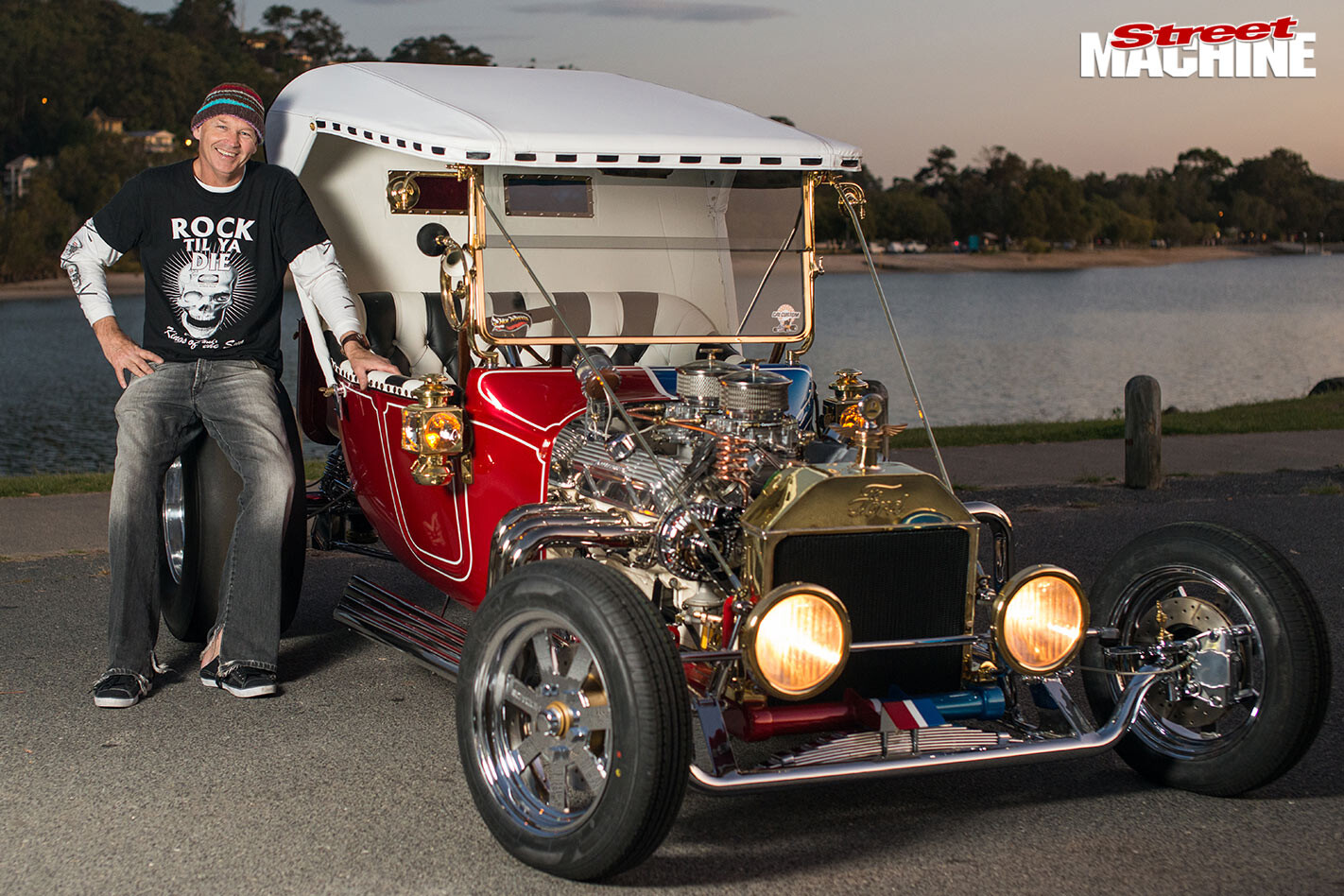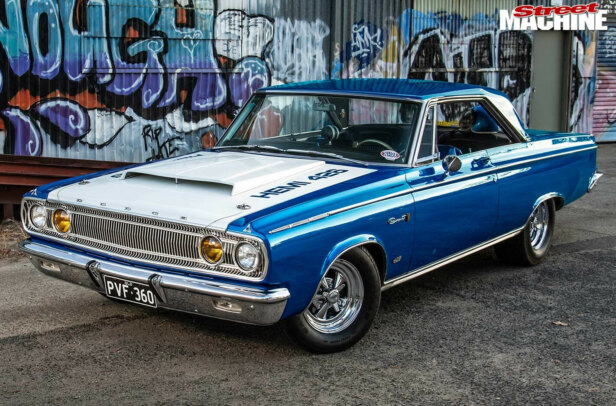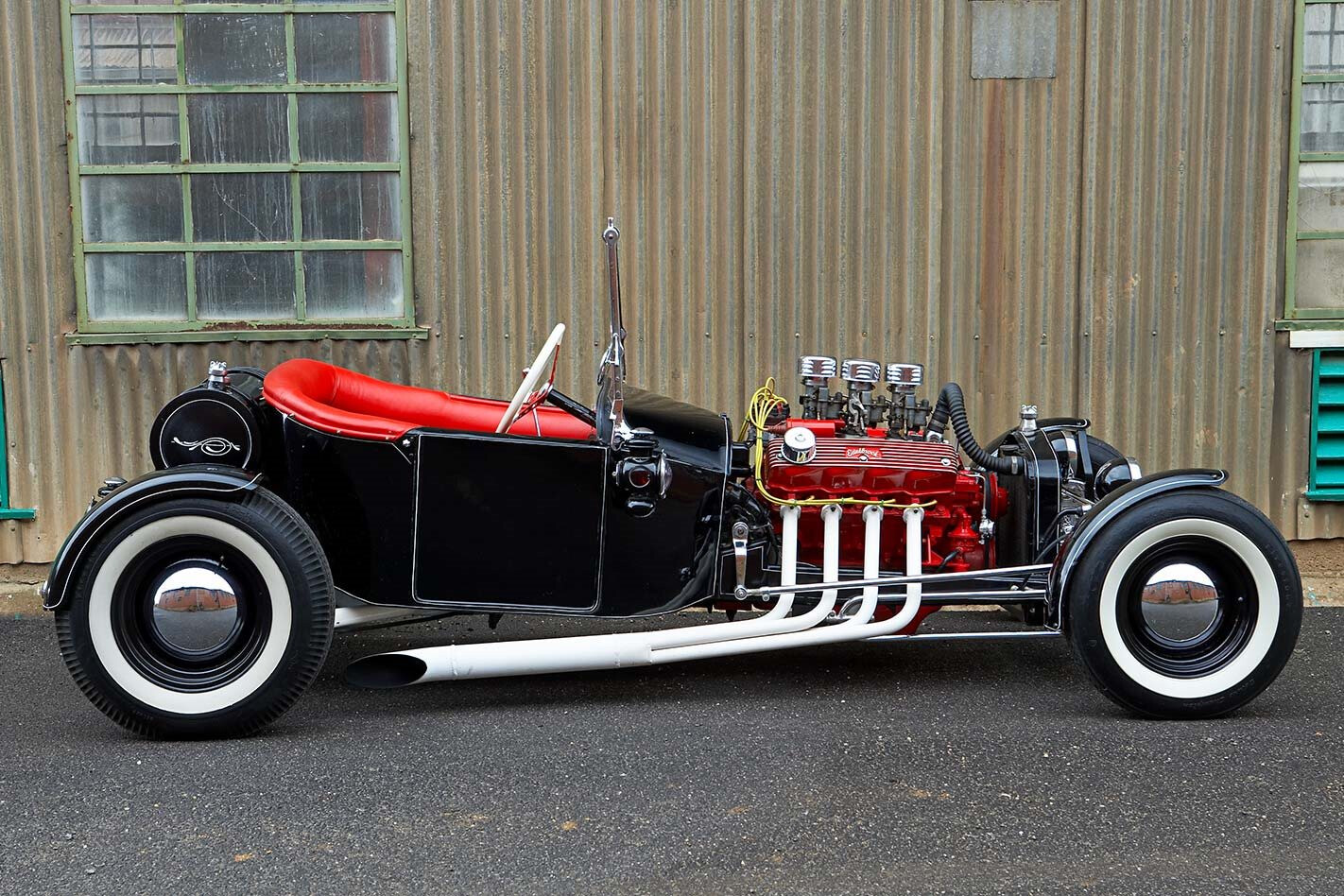Hard Rocker Clifford Hoad spent fifteen years building what could be Australia’s ultimate show ’n’ go Model T Ford
This article on Clifford’s Model T was originally published in issue 16 of the Street Machine Hot Rod magazine
I JUST woke up one day and said: ‘To hell with everything, I’m gonna build a real T-bucket,’” explains Clifford Hoad, owner and builder of this drop-dead-gorgeous Model T dubbed Splitt Decision. “I’ve since learnt that there is no ‘immediate’ when it comes to building a hot rod, so it took a little longer than most!”
A cool 15 years to be exact, but the proof is in the pudding. Take a look at the pics and you’ll see there’s not a square inch of this car that hasn’t been caressed, obsessed over or otherwise deliberated on by Cliff. Throw in the fact it was built predominantly with basic hand tools – a vice, hacksaw, drill, files, grinder and polisher – and the end result is even more remarkable.
But let’s click things back a notch. If the name Clifford Hoad sounds familiar, that’s because he carved out a solid reputation as the founding member and drummer for hard-rocking Aussie band Kings Of The Sun. The group achieved international success, including six years living in the States, the downtime of which Cliff spent indulging his other passion – Mopars.
A custom fuel tank and mounting straps are topped with a 1968 Lotus fuel cap, while a chromed nine-inch housing is supported by a coil-over and four-bar assembly
“I’ve always loved Chryslers and when I lived in the US I bought myself a ’70 Plymouth Road Runner with a 440 Six-Pack,” he says. “But rock ’n’ roll and hot rods go hand-in-hand, and I have long been a T-bucket fan too. As a kid I was obsessed with the Ts of Dick Knutson and Norm Longfield – not to mention Tommy Ivo’s – and remember seeing one on a rotunda at a hot rod shop in Vine Street that knocked me for six; I drooled down that window like a kid!”
The Kombi steering column has been detailed for period accuracy, while the pedals are custom-made to suit the tight confines around the 727 trans
Skip forward a few years and Cliff was back home, with the Road Runner now an Aussie citizen. “I rolled it heading to the Nambour Swap in ’98 and well and truly wrote it off. It was stuffed,” he says. “So I licked my wounds and then pondered the 440 now at my disposal – I felt guilty for crashing the Plymouth and wanted to make a good from a bad. That’s when I had an epiphany and chose to build a T, but one that combined Roaring 20s styling with 60s show-and-go. Truth be told, I had been collecting parts since the 70s so it was always on my dream list.”
The 440 Wedge donk came from Cliff’s wrecked ’70 Road Runner and retains Six-Pack internals. Dual Carter quads replace the original intake set-up for a period T-bucket look. The 0.100in thick stainless firewall was cut with a hacksaw at the rate of two inches a day, wearing out ten blades in the process
That was early ’99, and Cliff made a beeline for Ian Cameron at Designed Chassis. “I wanted mounts for the 440 and Ian said: ‘Well I suppose rego is out of the question.’ And that was it. I wanted to build my dream car and the only way was to bypass criticism from the governing bodies that make everything a no-no: You can’t chrome this, you must muffle that, you can’t run drag slicks on the street,” he laughs.
So Ian set to work, outfitting one of his chassis with a transverse-leaf, four-bar front end and dropped I-beam axle dampened via Rod-Tech shocks, while a Kombi steering box does its part to offset Cliff on the loud pedal. A nine-inch mounted via a four-bar and Aldan coil-overs sorts the driven end and packs 3.7 gears.
HQ calipers clamp DBA sport rotors at the front, with the Ford drums retained for the rear. The wheels are a story of their own – the front Hodads use centres hacksaw-cut by Cliff from 10mm plate before being chromed and mounted to 4.5-inch VW rims, while the rears are 16×10 magnesium Halibrands that began life fitted to Ash Marshall’s Scorcher rail!
A 440 Six-Pack is no slouch in a heavy B-body Mopar, let alone a ’glass bucket, so tromping on the gas is like driving on butter. Kevin Kent gave the big-block a freshen-up, stretching it to 452 cubes and replacing the Six-Pack set-up with twin 750 Carters on an Offenhauser intake. Eight two-inch stainless pipes packed with Harley baffles pretend to be an exhaust system, while a tried and proven Mopar Performance electronic ignition and transparent Zebra leads add show for the spark. A 727 Torqueflite trans was fitted with a shift kit and 2200 stall, and a drastically shortened ’57 Chrysler tailshaft was chosen for its period trunnion joints.
The two colours work nicely with the opposing rear glass, giving the T a distinct 3D-glasses look. “The twin shades hark back to the days of spraypainting our Dragster pushies and running out of paint midway,” Cliff says
When it came time for the body, Cliff was adamant about one thing: “It had to be narrow like a real Model T. I can’t stand the larger bodies that look like a jacuzzi on wheels. We dug up a battered but genuine real-steel 1922 bodyshell and took a mould from it. Proportion is everything, no matter what car you build, so it was the only option.”
The prominent use of brass is a mix of original Henry T items and handmade one-off pieces. “There were just as many hours in making the custom stuff as there was trying to pry the factory brass away from restorers. I listened to endless stories, ate boxes worth of Scotch Fingers and drank hundreds of cups of tea to score those parts”
The fibreglass bucket was prepped and initially painted pearl white by Dan Maddison, who then laid down the split-tone blue and red. “A hot rod should be red, but I love blue,” Cliff says. “In the end I couldn’t decide but the car started dictating to me what it wanted and we ended up with a ‘split decision’. It nailed the look I was chasing, is true to form for a crazy 60s-styled show rod and has just planted an identity like no other. I had my heart set on acrylic but Dan talked me into two-pack. I think it’s the first time in my life I’ve just said ‘okay’ about anything.”
The results speak for themselves, and the split colours also adorn the chassis and masterstroke 3D-glasses-style rear windows.
The exterior colours roll into the painted interior surfaces, while the seat base and roof frame are more of Cliff’s handiwork. Diamond-tuft black-and-white leather was another ‘split decision’, with Cliff again at a stalemate for colour choice
The windscreen is 1922 Dodge, while the roof mixes traditional T rake with Carson-style useability; the frame for the roof was handbuilt by Cliff and covered in white vinyl.
The interior features more of Cliff’s handiwork. The seat frames were custom-made with the help of Michael Maunsell and diamond-tufted by Martin Churchill in black-and-white English leather. The floor covering is rabbit fur – an old blanket swiped from Cliff’s grandmother – and the Stewart Warner instruments are flanked by a mahogany and kwila square steering wheel affixed to an original Model T brass spider.
“Oh, the wheel? Well, I literally cried making that; the madness of this project had finally hit me!” Cliff laughs. “I was sitting there with a small file grooving out the slots for the spokes and it was just the most tedious and painful job. I said to myself: ‘This is just fucked. What the hell am I doing?’ I had spent so many hours working on this car, deep in my own thoughts, that I felt it was never going to end.
“It was a lonely road, but I had to stay steadfast,” he continues. “Especially over such a long period; a lot can change in that time with car styling and what’s ‘cool’, but I homed in on the era from the start and stuck with it. I didn’t want to build a bitser.”
See the penny-clad radiator cap? Yep, Cliff searched for one dated 1922
Cliff’s tenacity paid off, with Splitt Decision deemed complete late in 2014. “It is a dream come true, no question,” he enthuses. “But my wife Lisa got me over the line. She was instrumental in me finishing the car when I had run out of steam and inspired me to continue the fine detail right through to the end. Our son Zen joined me for its maiden drive to Cooly Rocks 2015, and I could see Lisa bawling her eyes out at the traffic lights, so I know she is proud.
“It has been a massive journey for all of us but I am glad to have my weekends back to share with them. And my libido is back too; that has been a huge bonus!”
CLIFFORD’S T-BUCKET IN DETAIL
A. The engine detailing is extensive and includes a deburred, white-painted block along with plenty of brass and chrome
B. The repurposed glass air cleaner lids are the perfect indicator of Cliff’s state of mind during the build, and provide an amazing view of the atomisation process
C. The ‘Hodad’ front wheels use custom-made centres cut from 10mm plate by Cliff, using nothing more than a hacksaw — it took him two weeks. These were chromed and welded to 4.5in VW rims
D. Radiator supports were fashioned from quarter-inch solid brass. The radiator and headlamps are genuine 1915 Henry items
E. Wheel nuts all ’round are square-headed to match the brass lanterns and steering wheel, again made from scratch
F. The Ian Cameron chassis was hand-filed before being treated to two-tone blue and red paint
G. A 727 Torqueflite transmission was externally polished using a week’s worth of afternoons
H. A ’57 Chrysler tailshaft was chosen for its old-school trunnion joints and shortened dramatically to fit
CLIFFORD HOAD
1922 FORD T-BUCKET
Colour: Ford Blueprint/Mazda Velocity Red
ENGINE
Make: Chrysler 440ci
Block: Factory Wedge
Crank: Steel forged
Rods: Stock Six-Pack
Pistons: TRW 10.5:1
Camshaft: Iskenderian Six-Pack Cheetah
Intake: Offenhauser
Carbs: 2 x 750cfm Carter
Heads: Factory 906 castings, ported
Lifters: Iskenderian
Ignition: Mopar Performance orange box
Exhaust: 8 x 2in stainless headers, Harley baffles
SHIFT
Gearbox: 727 Torqueflite, shift-kitted
Converter: 2200 stall
Tailshaft: 1957 Chrysler, 13in-length
Diff: F100 nine-inch, 3.70 gears, 32-spline axles
BENEATH
Front: Transverse leaf, four-bar
Rear: Coil-overs, four-bar
Shocks: Stainless Rod-Tech (f), Aldan (r)
Brakes: DBA sport rotors with HQ calipers (f), Ford drums (r)
Steering: 1962 VW Kombi
ROLLING STOCK
Rims: Owner-made ‘Hodad’ 15×4.5 (f), Halibrand 16×10 (r)
Tyres: Nankang 135 (f), M&H Racemaster slicks (r)





Comments